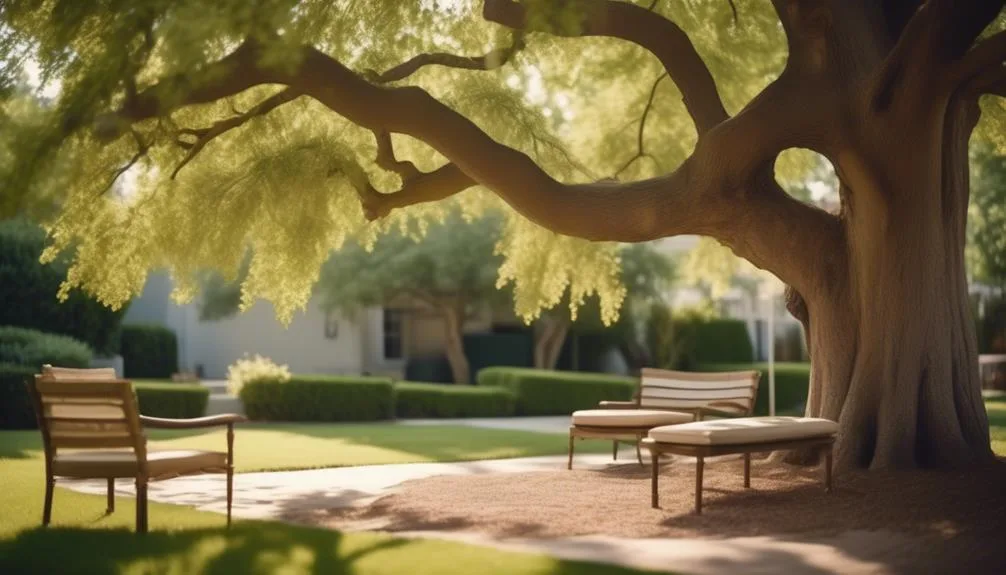Wondering if elm trees can provide the shade you need? Picture finding relief under the wide, leafy branches of these majestic trees.
Consider their potential to shield you from the sun's intensity. Elm trees offer unique qualities and varieties to create natural shade in your outdoor space.
Explore the possibilities and discover why these iconic trees could be the perfect choice for creating a cool retreat from the heat.
Elm Trees: Shade-Providing Characteristics
When selecting elm trees for shade, consider their wide, arching branches and dense foliage that offer excellent coverage and relief from the sun. Elm trees are known for their longevity, with some species having a lifespan of over 100 years when properly cared for.
However, they're susceptible to diseases such as Dutch elm disease and pests like elm leaf beetles. It's important to choose disease-resistant varieties and ensure proper maintenance to prolong their lifespan and keep them healthy.
Regular inspections and prompt treatment of any signs of disease or pest infestations are crucial in preserving the shade-providing qualities of elm trees.
Best Elm Tree Varieties for Shade
Considering the wide range of elm tree varieties available, it's essential to select ones that are well-suited for providing ample shade in your specific environment. When choosing elm trees for shade, consider these top varieties:
- American Elm (Ulmus americana): This classic elm variety is a popular choice for shade due to its broad, spreading canopy and vibrant fall foliage. It's a great option for landscaping ideas that require a large, majestic tree.
- Lacebark Elm (Ulmus parvifolia): With its attractive mottled bark and dense foliage, this elm variety not only provides excellent shade but also adds visual interest to your yard enhancement projects.
- Frontier Elm (Ulmus ‘Frontier'): Known for its rapid growth and adaptability, this elm variety is an excellent choice for those seeking quick shade benefits and minimal tree maintenance.
These elm tree varieties are ideal for providing shade and enhancing your yard's landscape.
Planting Elm Trees for Shade in Your Yard
To create a cooling oasis in your yard, consider the proper planting techniques for elm trees to ensure they provide optimal shade. When selecting trees for your yard landscaping, it's important to choose a variety of elm tree that is well-suited to your climate and soil conditions. Here's a helpful guide to get you started:
| Aspect | Details |
|---|---|
| Tree Selection | Choose a variety such as American, Lacebark, or Cedar Elm, known for their wide canopies and excellent shade-providing capabilities. |
| Planting Location | Select a spot with well-draining soil and full sun to partial shade, allowing enough space for the tree to reach its full size. |
| Planting Technique | Dig a hole twice as wide as the root ball, place the tree, backfill the hole, and water thoroughly. |
Caring for Elm Trees to Maximize Shade
After selecting the right variety of elm tree for your yard, maximizing shade requires proper care and maintenance to ensure the tree's canopy reaches its full potential. Here are three essential tips for caring for elm trees to maximize shade:
- Maximizing Growth: Elm trees thrive in well-drained soil and require regular watering, especially during dry spells. Consider using a slow-release fertilizer to promote healthy growth and provide essential nutrients for the tree to develop a robust canopy.
- Pruning Techniques: Regular pruning is crucial for shaping the elm tree's canopy and promoting dense foliage. Remove any dead or diseased branches to encourage new growth and enhance the tree's ability to provide ample shade.
- Maintenance: Keep an eye out for signs of disease or pest infestations, and promptly address any issues to maintain the tree's overall health and vitality.
Utilizing Elm Trees for Natural Shade Benefits
Utilizing elm trees for natural shade benefits involves strategically positioning the trees in your outdoor space to optimize their cooling effects and enhance your overall comfort. Elm trees offer numerous benefits beyond just providing shade. They contribute to the environment by absorbing carbon dioxide, releasing oxygen, and providing habitats for various wildlife.
The shade they provide can significantly reduce the temperature in your outdoor living areas, making them more enjoyable during hot summer months. By utilizing elm trees for shade, you can also lower your energy costs by reducing the need for air conditioning.
Additionally, the presence of these trees can enhance the aesthetics of your property and increase its value. When strategically placed, elm trees can have a positive environmental impact, making them an excellent choice for natural shade benefits.
Conclusion
Incorporating elm trees into your landscaping can create a cool and comfortable outdoor space. This is due to their wide canopies and dense foliage. Consider adding these trees to your yard to enjoy the natural shade they provide. This can enhance your outdoor experience.

My interest in trees started when I first saw the giant sequoias in Yosemite.
I was a teenager then, and I remember thinking, “I need to learn more about this.”
That moment stuck with me.
A few years later, I went on to study forestry at Michigan Tech.
Since graduating, I’ve worked in a mix of hands-on tree care and community education.
I’ve spent over ten years helping people understand how to plant, maintain, and protect the trees in their neighborhoods.
I don’t see trees as just part of the landscape.
They are living things that make a real difference in our daily lives.
